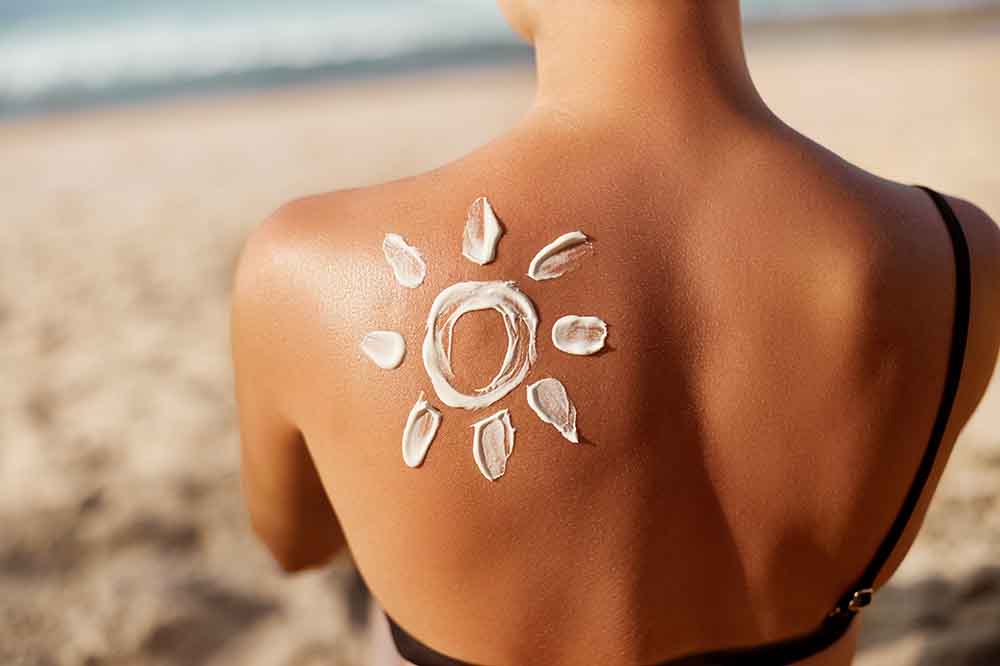Sun exposure can significantly damage your skin, leading to premature aging, pigmentation, and in severe cases, even skin cancer. That's why it's crucial to protect your face by applying sunscreen daily, regardless of the weather. Sunscreen forms a barrier against the sun's harmful ultraviolet (UV) rays, which can cause both short- and long-term skin damage. This article explores how to apply sunscreen on your face correctly, why it's essential, and the different types of sunscreens you can choose from.
Benefits of Applying Sunscreen
The advantages of incorporating sunscreen into your daily skincare routine are numerous. Firstly, sunscreen provides protection from harmful UV rays, reducing your risk of sunburn and long-term skin damage. It also helps prevent premature aging, such as wrinkles, fine lines, and dark spots, which are often caused by unprotected sun exposure. Sunscreen helps in preventing skin cancer by blocking UV radiation, which is a significant risk factor. Moreover, sunscreen keeps your skin hydrated and maintains an even skin tone, preventing pigmentation issues caused by the sun. Lastly, consistent use of sunscreen promotes overall skin health, ensuring your skin remains youthful and vibrant.
What is SPF and What Does it Mean?
SPF, or Sun Protection Factor, is a critical number when it comes to choosing the right sunscreen for your skin. It measures the effectiveness of sunscreen in shielding your skin from UVB rays, the primary cause of sunburn and a significant contributor to skin damage and cancer. SPF is calculated by comparing the amount of time it would take for UVB rays to redden your skin with sunscreen applied, versus the amount of time without it.
A higher SPF number indicates a greater level of protection, but it's important to note that the difference in protection between high-SPF sunscreens is not as significant as many think. For example, while SPF 30 blocks 97 per cent of UVB rays, SPF 50 only blocks about 98 per cent. The additional protection provided by SPF 50 or higher is marginal compared to SPF 30.
SPF should also be considered alongside the duration of sun exposure and the intensity of the sun. If you’re going to be outdoors for long periods or during peak sunlight hours (10 am to 4 pm), it’s recommended to opt for a higher SPF, like SPF 50, to provide better protection.
When selecting sunscreen, remember that no sunscreen offers 100 per cent protection. Even a sunscreen with a high SPF can wear off due to sweating, swimming, or towel-drying, so reapplication is crucial for continued protection.
In addition to SPF, consider looking for broad-spectrum sunscreens, which protect against both UVA and UVB rays. UVA rays can cause long-term skin aging and increase the risk of skin cancer, which is why broad-spectrum protection is essential for complete sun defence.
It's also important to consider your skin type when choosing SPF. Individuals with fair or sensitive skin, or those prone to burning, may benefit from higher SPFs, while those with darker skin may not need as high an SPF but should still protect themselves from UV damage.
Lastly, it’s important to remember that SPF ratings are determined in ideal, controlled conditions. In real-life scenarios, sunscreen can be applied unevenly or insufficiently, which can impact its effectiveness. Therefore, ensure you’re applying enough sunscreen (about a nickel-sized amount for your face) and reapplying as needed for optimal sun protection.

Types of Sunscreens
Sunscreens come in several different forms, each offering different application experiences and levels of protection. Here are the most common types:
1. Chemical Sunscreens: These absorb UV rays and transform them into heat, which is then released from the skin. They're lightweight and often ideal for those who prefer a non-greasy finish.
2. Physical (Mineral) Sunscreens: These contain minerals like zinc oxide or titanium dioxide that sit on top of the skin, reflecting UV rays. They're often recommended for sensitive skin and provide immediate protection after application.
3. Spray Sunscreens: These are convenient for quick application, especially in hard-to-reach areas like the back. However, you must ensure even coverage to ensure protection.
4. Cream and Lotion Sunscreens: These provide richer, more hydrating options and are ideal for dry skin. They're thicker than sprays and often offer long-lasting protection.
5. Stick Sunscreens: These are compact and ideal for touch-ups during the day, especially around sensitive areas like the eyes.
How to Choose the Right Sunscreen for Your Face
Choosing the right sunscreen can be confusing given the variety of options available. When selecting sunscreen, consider the following:
1. SPF Level: For daily use, choose a sunscreen with at least SPF 30. If you plan on being outdoors for extended periods or have fair skin, opt for SPF 50 or higher.
2. Skin Type: If you have oily or acne-prone skin, consider using oil-free, non-comedogenic sunscreens that won’t clog your pores. For dry skin, choose moisturising formulas that provide added hydration.
3. Broad-Spectrum Protection: Look for sunscreens labelled as ‘broad-spectrum,’ as they protect against both UVA (ageing) and UVB (burning) rays.
4. Water Resistance: If you're going swimming or will be sweating, choose a water-resistant sunscreen to ensure it stays effective.
5. Ingredients: For sensitive skin, opt for physical sunscreens with ingredients like zinc oxide or titanium dioxide, which are less likely to cause irritation.
How to Apply Sunscreen on Face Correctly
Now that you know the importance of sunscreen, it's time to learn how to apply it the right way. Here’s a simple guide on how to apply sunscreen on face:
1. Start with Clean Skin: Wash your face with a gentle cleanser and pat dry. Sunscreen works best when applied to clean skin.
2. Use the Right Amount: Apply a generous amount to your face. The general rule is to use about half a teaspoon for your face and neck. This ensures sufficient coverage for proper protection.
3. Even Application: Use your fingers to apply sunscreen evenly on your face, making sure to cover every area, including your ears and the back of your neck.
4. Be Gentle Around Sensitive Areas: When applying sunscreen near your eyes, be cautious not to get it in your eyes. You can use a mineral sunscreen specifically formulated for the eye area.
5. Allow Absorption: Give the sunscreen a few minutes to absorb into your skin before applying makeup or other products.
How Much Sunscreen Should One Use on the Face?
For optimal sun protection, it’s essential to use the right amount of sunscreen. According to dermatologists, you should use about 1/2 teaspoon (or 2 millilitres) of sunscreen for your face alone. This quantity ensures that your skin is fully protected from harmful UV rays. Applying too little may not offer the necessary protection, while applying more than needed can leave your skin feeling greasy and uncomfortable. Make sure to apply sunscreen evenly to all exposed areas of your face.
When to Reapply Sunscreen
Sunscreen is not a one-time application. It’s crucial to reapply sunscreen every two hours, or more frequently if you’ve been swimming, sweating, or wiping your face. Even water-resistant sunscreens need to be reapplied after swimming or heavy perspiration. Additionally, reapply sunscreen after touching your face, as this can remove or displace sunscreen from your skin.
Do You Need to Wear Sunscreen Indoors?
Many people assume they only need sunscreen when they are outdoors. However, harmful UV rays can penetrate windows and affect your skin even when you’re inside. Indoor sources of UV radiation, like sunlight coming through windows, can still cause skin damage over time. If you’re sitting near a window or spend a lot of time under artificial lighting (like fluorescent lights), it’s a good idea to apply sunscreen to your face as part of your morning routine, even if you don’t plan on going outside.

Conclusion
Applying sunscreen correctly is not just a step in your skincare routine—it's a vital action to safeguard your skin from the damaging effects of the sun. By forming a protective layer against ultraviolet (UV) rays, sunscreen plays a crucial role in maintaining your skin's health and preventing a range of skin issues, from premature ageing to more severe conditions like skin cancer.
Sunscreen and Skin Health: One of the most significant benefits of sunscreen is its ability to protect against both UVA and UVB rays. UVA rays, which cause premature aging and skin damage, and UVB rays, responsible for sunburn, both contribute to the development of wrinkles, fine lines, and sunspots. With consistent sunscreen use, you can dramatically reduce these signs of ageing, keeping your skin looking youthful and vibrant for longer.
Moreover, sunscreen helps to maintain an even skin tone. It prevents hyperpigmentation (dark spots) caused by sun exposure, which is particularly important for individuals with sensitive skin or those prone to melasma. Over time, this protection leads to clearer, healthier skin that is less prone to discoloration and sun-induced damage.
Remember: how to apply sunscreen on your face correctly involves applying a sufficient amount, choosing the right type, and reapplying it throughout the day to ensure your skin stays protected.
FAQs
How often should I reapply sunscreen on my face?
Reapply sunscreen every two hours, or more frequently if you’re sweating, swimming, or wiping your face.
Can I apply sunscreen on top of my makeup?
Yes, you can apply sunscreen on top of makeup using a setting spray or sunscreen stick for touch-ups.
Is it necessary to apply sunscreen if I have makeup on?
Yes, sunscreen should be applied as the first layer before makeup for full protection. Consider using makeup with built-in SPF for added protection.
Can I use sunscreen on my face if I have sensitive skin?
Yes, use a physical sunscreen with zinc oxide or titanium dioxide, as they are less likely to irritate sensitive skin.
Is SPF 30 enough for daily use?
SPF 30 offers sufficient protection for daily use, but if you’re in direct sunlight for extended periods, SPF 50 or higher is recommended.